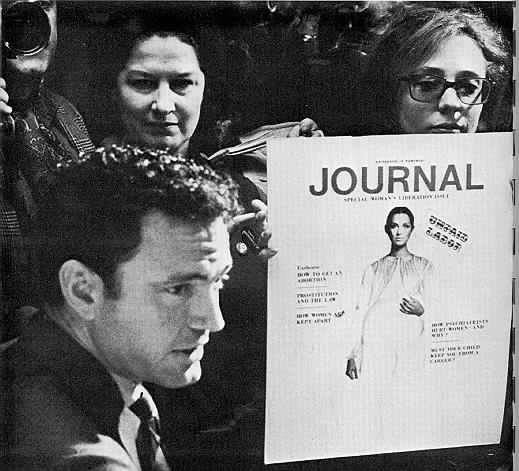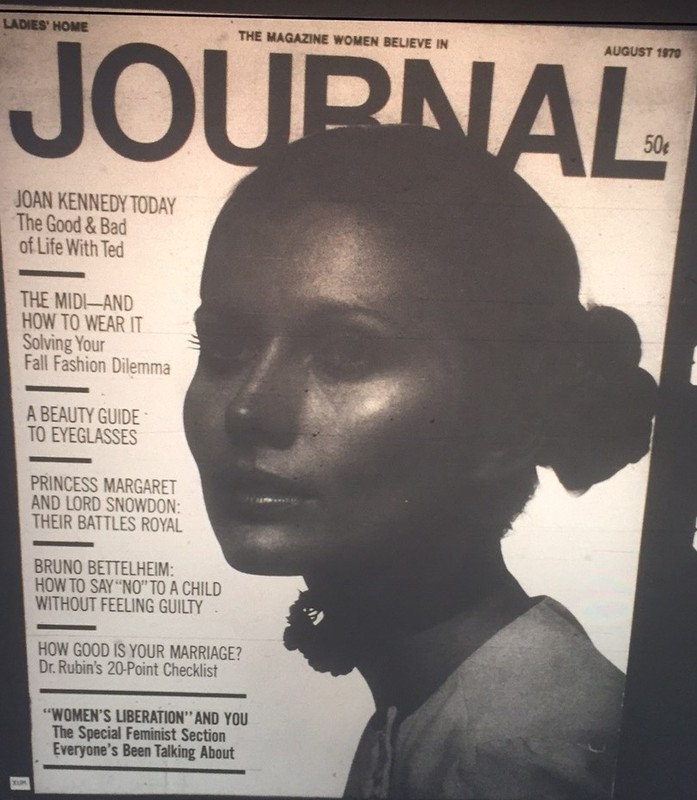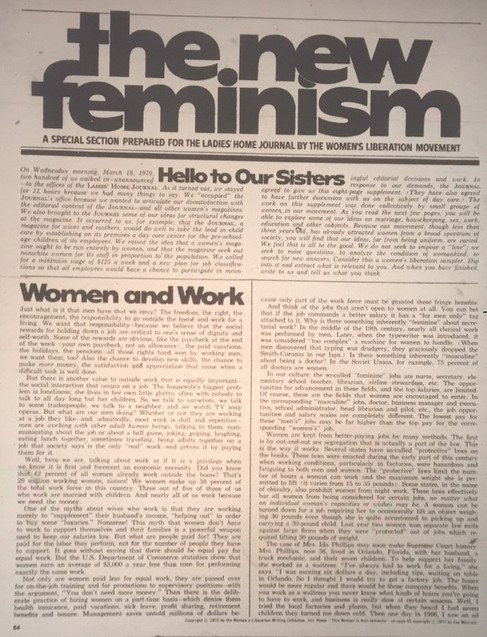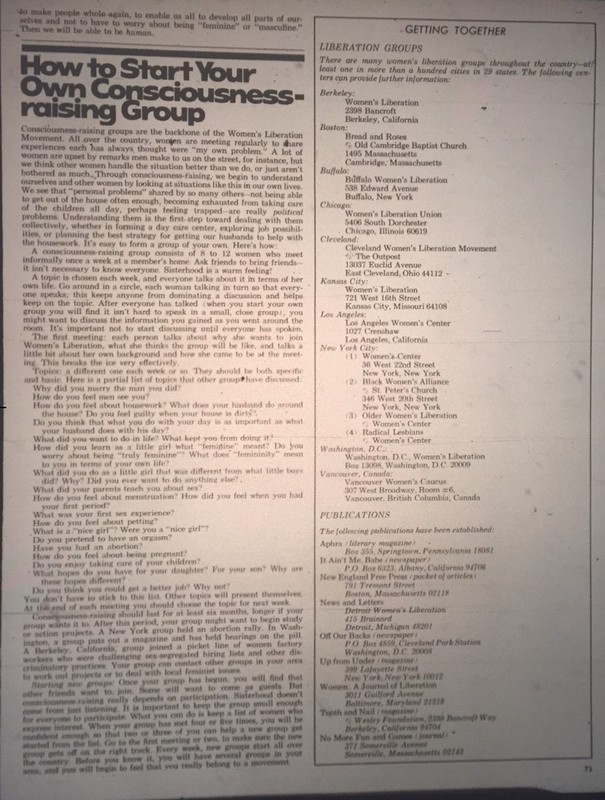1970 Ladies Home Journal Sit-in
Introduction
Text-to-speech Audio
Images
John Carter and some of the protestors

Cover of the August Edition

The first article

The last article of the special section of the August edition

Backstory and Context
Text-to-speech Audio
The protest began at 9:15 AM as a group of women led by notable feminists Susan Brownmiller, Ti-Grace Atkinson and Shulamith Firestone occupied the magazine's offices. At this time in history, many women's magazines were led by all-male executive staffs. From the perspective of a growing number of women, these magazines often contained articles that were insulting to women. The group needed to focus their energy on one magazine, and chose the Ladies Home Journal because of its vast circulation. This magazine was also selected for a reason of convenience--one of the women was a former employee who still had access to the building.
With this "insider access" the women were able to enter the building quietly and made their way into the magazine's offices in small numbers until over one hundred had gained control of the editor's office. The protesters centered many of their protests around the content of the magazine, arguing that many of the articles were “irrelevant, unstimulating and demeaning to the women of America.” From their perspective, the editorial focus on fashion, beauty, and housework presented a limited sphere of acceptable activity for women. The protesters presented a list of demands and offered several alternative articles they believed would challenge readers to consider feminist ideas.
The protesters also envisioned an all-female staff at this women's magazine, a demand that necessitated the replacement of editor John Mack Carter and other staff members. The protesters also called for equal pay for women staff members, many of whom were paid much less than their male counterparts. Additional suggested reforms included editorial meetings that would be open to all employees to voice their opinions, rejecting advertisements deemed demeaning to women, and a free daycare to assist the staff with children.
As an example of one of the specific editorial suggestions offered by the protesters, the group called for the discontinuation of the columnn titled “Can this Marriage be Saved?” which the group believed placed the burden of "saving" a marriage on women. The group also offered suggestions for new articles about divorce, articles about how women might respond to social issues that affected women, and how detergents harm the environment. They also challenged the magazine to acknowledge the experience of single mothers.
After eleven tense hours, thee protesters and management reached a compromise. Carter agreed to have provide space for the group to present their perspectives in the August issue-a section that is included in this entry. Management also a greed to create a free day-care program and editorial training for female employees who were interested in becoming more involved in editorial content. Even though Carter didn’t meet all of the groups demands, including his own replacement, the media coverage of the protest spread the ideas of the organization and represent an important event in the long history of feminist thought.
The magazine's August issue featured several articles from the protesters. The first article discussed women's desire to work beyond the home, and the need for equal pay for women-especially single mothers. The next article discussed sexism and how limited and even negative ideas about gender were shaped at a young age. For example, one article discussed how young men were raised to prepare for a wide range of professional careers and were taken more seriously in school. The next article discussed the process of delivering a baby and how the role of young mothers were often under-appreciated in society.
After the request to end the "Can this Marriage be Saved?" columnn was rejected, the group offered a new columnn entitled “Should this Marriage be Saved?" This columnn rejected the idea that it was up to women to "save their marriage" by pleasing their husbands. The article acknowledged that many women were in dissatisfying relationships that demanded that they surrender their identity and ambition. The article offered an example of a woman who escaped this situation through divorce and became a researcher. The article concluded with measures that the government might take to assist women who are seeking a divorce.
Finally, the protesters offered a critique of the magazine's emphasis on fashion and preconceived standards of physical beauty. One article challenged these ideas by discussing how women are often perceived on a scale of beauty that presents them as either desirable or undesirable sex objects. This article argued that society prescribes roles for women that limit womanhood to serving the needs and sexual appetites of men. The next article challenged the idea that this pleasure was a one-way relationship and also challenged the notion that sex was a taboo.
The section concluded with a call to action that encouraged the reader to start their own "consciousness-raising groups," complete with a list of topics for discussion. Had the protest occurred later in the decade, the organizers might have also challenged the magazine to discuss the experiences of non-white and non-straight women, an important part of "Third Wave" feminism that sought greater inclusion and grew throughout the 1970s.
Sources
Dismore, David. Founding Feminists: March 18, 1970. Feminist Majority Foundation., 3/18/14. Accessed Web, 5/2/17. https://feminist.org/blog/index.php/2014/03/18/founding-feminists-march-18-1970/.
Hunter, Jean E.. "A Daring New Concept: "The Ladies' Home Journal" and Modern Feminism." NWSA Journal, vol. 2, no. 4, 583-602. Published Autumn 1990. JSTOR.
